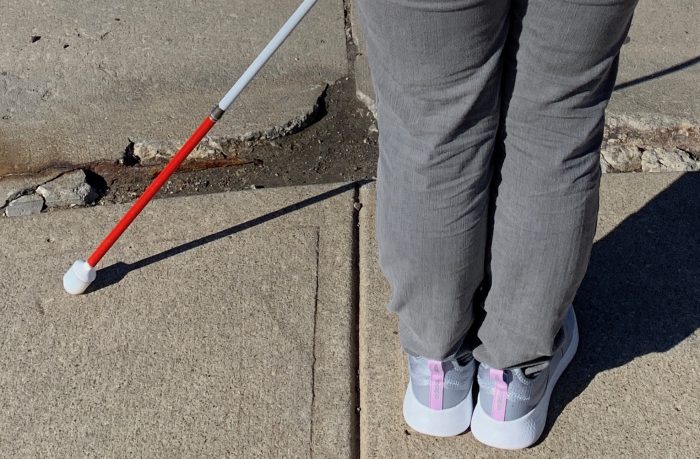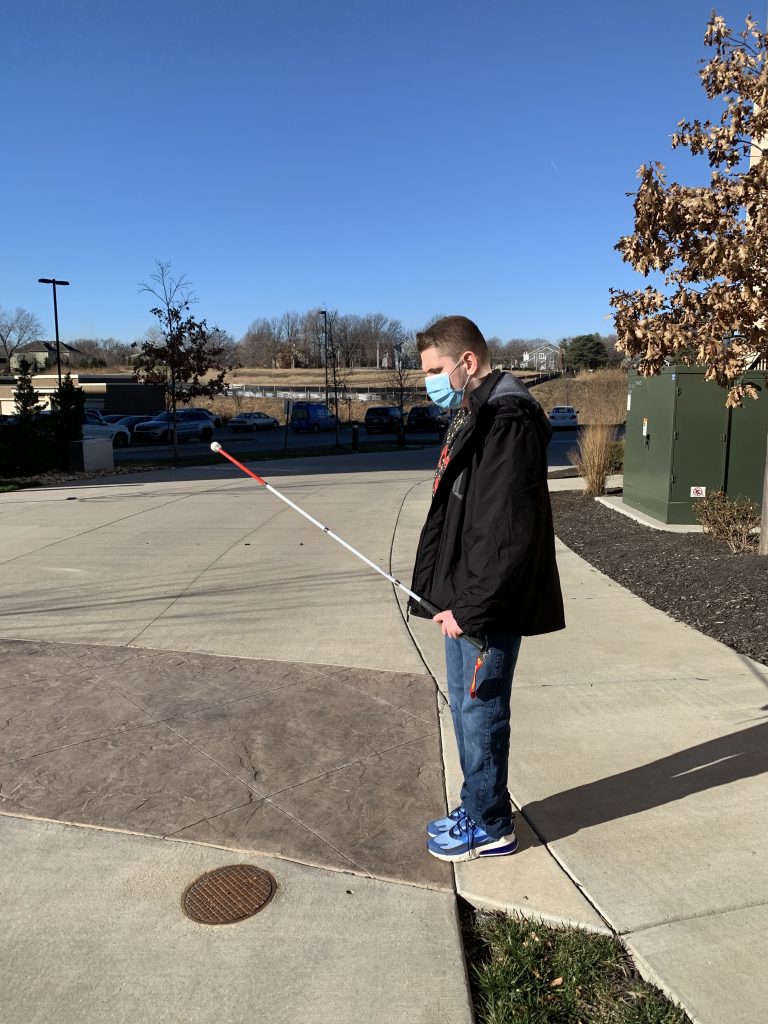Flag my White Cane?

What does it mean to Flag with the White Cane
By Patrick Wilson, high school student
Introduction:
There is some controversy involving flagging your cane and how high it should go. I am writing this blog to educate people on what flagging is and explain some of its discussion.
About flagging:
Flagging is when the user of a cane is standing at a street, crosswalk, or any other area where they can cross where cars may move. Flagging involves lifting the cane in the air to tell drivers that the user has a visual impairment. The methods used for flagging vary depending on the user and the environment.
The idea behind this blog:
My Orientation and Mobility (O and M) instructor took a picture of me flagging my cane at an intersection and posted it to the school’s Facebook page. Some people posted on Facebook about how flagging was not taught to them, which led to a discussion on different ways to flag.
What happens when you flag:
When you flag, you send a signal to drivers to tell them you have a white cane and are visually impaired. The higher you flag, there is a generally higher chance that the driver will see you. If you flag low, the driver won’t be able to see the motion of you flagging.
Distracted drivers (drivers who are using their phone or are generally not paying attention) may also be able to see the cane if it is flagged high enough into the air.
The controversy behind flagging:
Some instructors think that it is good to flag any time you’re crossing a street, some think only when in traffic, and some others feel that flagging is not needed at all.
Even though it is taught more now, at least at our school, flagging wasn’t taught as much in the past.
Flagging changes:
Flagging has changed over the years based on new information. With this in mind, it is more critical to flag in the case of silent cars. Blind people rely on the engine of a vehicle to hear where it is and where it is going. With the new generation of silent cars, it is harder for blind people to listen for an electric car. This is why it is essential that drivers abide by state law.

White Cane Law:
White Cane law states that drivers must come to a stop whenever someone is using a cane or a dog guide to cross the street.
Variations in White Cane Law
White cane law varies depending on the state you’re in. Each state has its own set of rules regarding the cane and how drivers have to abide by it when they see a person holding a white cane and crossing a street.
White Cane Law research:
While researching flagging, I also looked into White Cane law to see if flagging was mentioned, and I found the following:
In Missouri, the driver is liable for any damage inflicted on a pedestrian. The fines are still relatively low, considering personal injury is involved. While researching White Cane Law, the last updated resource I found was dated October 2013, so laws might have changed since then. Most states have the same laws, but the consequences vary depending on the state. In some states, you can face jail time, and in others, you’ll have to pay a fine. Other states provide a mix of both consequences.
Conclusion:
In this blog, I discussed the controversy in flagging, the fact that some people weren’t aware of flagging, how flagging works in general, and the laws specifically about the cane and crossing streets.
White cane research resources:
For more information about the white cane and research that has been done, you can read this JVIB article.
I found information about the white cane and state laws that you might find interesting.
This Post Has 118 Comments
Comments are closed.



vegas slots online free https://2-free-slots.com/
play slots https://freeonlneslotmachine.com/
slots machines free online https://candylandslotmachine.com/
real penny slots https://pennyslotmachines.org/
dancing drums free slots https://slotmachinesworld.com/
egg poacher – 3 slots https://slot-machine-sale.com/
big win vegas slots https://beat-slot-machines.com/
free slots 777 https://download-slot-machines.com/
free slots real cash https://411slotmachine.com/
slots of montana https://www-slotmachines.com/
triple diamond slots https://slotmachinegameinfo.com/
is a dissertation peer reviewed https://buydissertationhelp.com/
writing a methodology for dissertation https://dissertationwriting-service.com/
best dissertation writing company https://help-with-dissertations.com/
mba dissertation writing services https://mydissertationwritinghelp.com/
cheap dissertation writing service uk https://dissertations-writing.org/
dissertation writing books https://helpon-doctoral-dissertations.net/
2council
online dissertation help https://professionaldissertationwriting.org/
premium dissertation writing service https://professionaldissertationwriting.com/
help dissertation dissertation help https://helpwithdissertationwritinglondon.com/
dissertation editing services https://dissertationwritingcenter.com/
dissertation proposal help https://dissertationhelpexpert.com/
tips for writing a dissertation https://accountingdissertationhelp.com/
writing your dissertation proposal https://writing-a-dissertation.net/
masters dissertation https://bestdissertationwritingservice.net/
medical dissertation writing service https://businessdissertationhelp.com/
dissertation writing software https://customdissertationwritinghelp.com/
citing a dissertation https://writingadissertationproposal.com/
dissertation plan https://dissertationhelpspecialist.com/
thesis vs dissertation https://dissertationhelperhub.com/
how to write a dissertation proposal https://customthesiswritingservices.com/
caesars pa online casino https://download-casino-slots.com/
foxwood casino online https://firstonlinecasino.org/
casino online usa https://onlinecasinofortunes.com/
ocean online casino login https://newlasvegascasinos.com/
river casino online https://trust-online-casino.com/
online blackjack casino https://onlinecasinosdirectory.org/
paradise online casino https://9lineslotscasino.com/
parx online casino pa https://free-online-casinos.net/
online casino websites https://internet-casinos-online.net/
betfair online casino nj https://cybertimeonlinecasino.com/
platinum play online casino https://1freeslotscasino.com/
real online casino win real money https://vrgamescasino.com/
mobile casino online https://casino-online-roulette.com/
best online casino no deposit https://casino-online-jackpot.com/
free online casino games real money no deposit https://onlineplayerscasino.com/
best online casino pa https://all-online-casino-games.com/
why online gambling is more dangerous than casino gambling https://casino8online.com/
best vpn https://freevpnconnection.com/
best free vpn for chromebook https://shiva-vpn.com/
best vpn for router https://freehostingvpn.com/
vpn gratis https://ippowervpn.net/
buy vpn server https://imfreevpn.net/
vpn for mac free https://superfreevpn.net/
avast free vpn https://free-vpn-proxy.com/
p2p vpn free https://rsvpnorthvalley.com/
military gay dating https://gay-singles-dating.com/
fat chub gay dating https://gayedating.com/
best dating online site https://freephotodating.com/
internet dating services https://onlinedatingbabes.com/
dating gmail germany https://adult-singles-online-dating.com/
adilt dating https://online-internet-dating.net/
asien dating online https://speedatingwebsites.com/
sexy dating apps https://datingpersonalsonline.com/
good dating sites https://wowdatingsites.com/
date internet site https://lavaonlinedating.com/
american dating https://virtual-online-dating-service.com/
over dating https://zonlinedating.com/
relative dating https://onlinedatingservicesecrets.com/
nj online casino promo codes https://onlinecasinos4me.com/
casino online game https://online2casino.com/
best online casino promotions https://casinosonlinex.com/
local gay chat rooms https://newgaychat.com/
gay tranny webcam chat https://gaychatcams.net/
gay universe man chat https://gaychatspots.com/
best gay chat https://gay-live-chat.net/
gay videeo chat https://chatcongays.com/
good chat to meet gay men are bi https://gayphillychat.com/
free gay phone chat lines https://gaychatnorules.com/
b gay chat https://gaymusclechatrooms.com/
1-800 contacts refined gay men chat https://free-gay-sex-chat.com/
reddit gay sex chat room https://gayinteracialchat.com/
older gay chat https://gaymanchatrooms.com/
ghost writer for college papers https://term-paper-help.org/
help me with my paper https://sociologypapershelp.com/
dltk custom writing paper https://uktermpaperwriters.com/
custom paper writing https://paperwritinghq.com/
papers writing service https://writepapersformoney.com/
write my college paper for me https://write-my-paper-for-me.org/
find someone to write my college paper https://doyourpapersonline.com/
pay someone to write a paper https://top100custompapernapkins.com/
online paper writers https://cheapcustompaper.org/
can i pay someone to write my paper https://writingpaperservice.net/
buy papers online https://buyessaypaperz.com/
do my college paper https://mypaperwritinghelp.com/
where can i find someone to write my college paper https://writemypaperquick.com/
buy school papers online https://essaybuypaper.com/
write my persuasive paper https://papercranewritingservices.com/
paper writing company https://premiumpapershelp.com/
professional paper writer https://ypaywallpapers.com/
what should i write my paper on https://studentpaperhelp.com/
3retains
courseworks help https://brainycoursework.com/
differential equations coursework https://courseworkninja.com/
creative writing coursework ideas https://writingacoursework.com/
cpa coursework https://mycourseworkhelp.net/
coursework uk https://courseworkinfotest.com/
coursework sample of written work https://teachingcoursework.com/
coursework project https://courseworkdomau.com/
free online sating https://freewebdating.net/
online dating games https://jewish-dating-online.net/
best online dating and chatrooms travel https://sexanddatingonline.com/
senior bi log in https://onlinedatingsurvey.com/
free date https://onlinedatinghunks.com/
dating chat site https://datingwebsiteshopper.com/
best local dating sites https://allaboutdatingsites.com/
meet single women https://freewebdating.net/